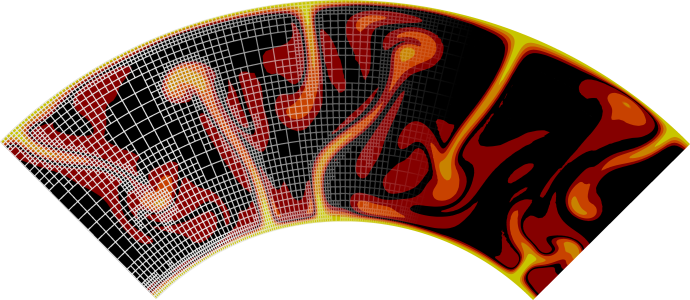The structure of parameter files#
Most of the run-time behavior of ASPECT is driven by a parameter file that looks in essence like this:
set Dimension = 2
set Resume computation = false
set End time = 1e10
set CFL number = 1.0
set Output directory = output
subsection Mesh refinement
set Initial adaptive refinement = 1
set Initial global refinement = 4
end
subsection Material model
set Model name = simple
subsection Simple model
set Reference density = 3300
set Reference temperature = 293
set Viscosity = 5e24
end
end
Some parameters live at the top level, but most parameters are grouped into subsections. An input parameter file is therefore much like a file system: a few files live in the root directory; others are in a nested hierarchy of sub-directories. And just as with files, parameters have both a name (the thing to the left of the equals sign) and a content (what’s to the right).
All parameters you can list in this input file have been declared in ASPECT. What this means is that you can’t just list anything in the input file, and expect that entries that are unknown are simply ignored. Rather, if your input file contains a line setting a parameter that is unknown, you will get an error message. Likewise, all declared parameters have a description of possible values associated with them - for example, some parameters must be non-negative integers (the number of initial refinement steps), can either be true or false (whether the computation should be resumed from a saved state), or can only be a single element from a selection (the name of the material model). If an entry in your input file doesn’t satisfy these constraints, it will be rejected at the time of reading the file (and not when a part of the program actually accesses the value and the programmer has taken the time to also implement some error checking at this location). Finally, because parameters have been declared, you do not need to specify a parameter in the input file: if a parameter isn’t listed, then the program will simply use the default provided when declaring the parameter.
Note
In cases where a parameter requires a significant amount of text, you can end a line in the input file with a backslash. This indicates that the following line will simply continue to be part of the text of the current line, in the same way as the C/C++ preprocessor expands lines that end in backslashes. The underlying implementation always eats whitespace at the beginning of each continuing line, but not before the backslash. This means that the parameter file
set Some parameter = abc\
def
is equivalent to
set Some parameter = abcdef
that is, with no space between abc and def despite the leading whitespace at the beginning of
the second line. If you do want space between these two parts, you need to add it before the
backslash in the first of the two lines.
Note
If you want to run several models that are all small modifications of a base model you can
include the base model in the modified model parameter files to include its parameters.
This means that in a parameter file file_a.prm that contains
set Some parameter = abc
include file_b.prm
set Some other parameter = def
the content of file file_b.prm will be inserted at the position of the
include statement. If file_b.prm includes further include statements, these will
be recursively substituted until no statements remain or you reach the maximum number
of supported include statements, in which case ASPECT will stop and output an error message.
Note, that if the same parameter is set twice in parameter files, the last
occurrence will overwrite the earlier occurrence(s). Thus, in the example above if file_b.prm contains both
Some parameter and Some other parameter, then the final file will use the value of
Some parameter from file_b.prm, but the value of Some other parameter from file_a.prm.
Also note, that the include statement can include the file path as a relative or absolute path,
and you can also reference the original ASPECT source directory using the string $ASPECT_SOURCE_DIR.
Thus the three include statements
include file_a.prm
include /home/user/aspect/file_a.prm
include $ASPECT_SOURCE_DIR/file_a.prm
could all include the same file, but the second and third statement are independent from your current working directory, while the first one depends on where you execute ASPECT.

